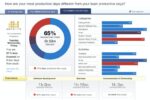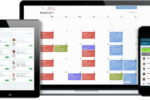- Developers
- Developer Blog
- Software Development
- Requirements Document Examples to Inspire You

profile

By Aran Davies
Verified Expert
8 years of experience
Aran Davies is a full-stack software development engineer and tech writer with experience in Web and Mobile technologies. He is a tech nomad and has seen it all.
Are you looking for some excellent requirements document examples?
When it comes to developing a functional requirements document, the key is to clearly and comprehensively communicate project requirements and other relevant information to the development team.
In fact, the top requirements documents examples all have something in common, i.e. they all provide project managers with enough room to communicate business needs and project scope.
That said, it can be difficult to determine what such a specification document looks like and whether you can actually create a requirements document template that works just well for you.
In this article, I’ll provide some of the best product requirements document examples, along with a guide on how to create one for your product.
Let’s get started with product requirements document examples.
What is a Product Requirements Document [An Overview]
A Product requirements document is an outline of the key requirements that a company has for its product.
A document created by product managers after extensive discussions with developers, business analysts, and key stakeholders, and detailed customer analysis.
A PRD is different from a Business Requirements Document (BRD), Functional Requirements Document (FRD), Marketing Requirements Document (MRD), and a Software Requirements Specification (SRS), in that it’s focused more on the specific requirements of the product instead of why the business wants the product to exist, and what the final product should look
A typical PRD contains the basic purpose of the software product, the product’s proposed features, the release readiness criteria, the intended user flow, and UI design, as well as any concluding insight, assumptions, dependencies, and future work.
Depending on the size of the company and the number of overlapping products they have, a PRD could vary in size, from a single-page document to one consisting of multiple pages and containing interactive elements.
5 Top Requirements Documents Examples
Whether you’re creating a document to serve as a software development guideline, or just to communicate the technical requirements of a product, these examples will help you get the specs across.

Get a complimentary discovery call and a free ballpark estimate for your project
Trusted by 100x of startups and companies like
Here are the best PRD examples that I have found.
1. Atlassian
The Atlassian product document template provides a stable and agile platform for all your pre-launch product prep, as well as post-launch usability metrics analysis.
It’s a simplistic template that still has all the required sections for a thorough description of all the deliverables, as well as space for end-user-based product assumptions.
What’s best about the Atlassian template is that abides by the Agile methodology while still providing support for traditional environments.
On top of that, it allows project management heads to act as a bridge between stakeholders and developers by having sections for the entire product life cycle.
The benefits of the Atlassian PRD template include:
- Instructions and examples for each section to help managers insert the right information;
- A clean, no-frills document with minimal distractions;
- Interactive workstreams, graphics, flowcharts, and data sheets;
- Seamless linking to Jira tasks/issues, Google Docs, and various plugins.
Additionally, Atlassian offers a whole host of value-added functionality for product managers.
To download the template visit Atlassian.
2. Slite
Slite offers a clean and concise product requirements template that has space for all the necessary data yet is direct enough to not be long-winded.
Designed to be centered on user stories instead of functional and non-functional requirements, the template is ideal for agile teams with streamlined business processes.
What separates the Slite template from the rest is the focus on an Agile workflow and the attempt to move away from redundant details which would have little to no importance for the final product. Since Agile environments focus more on use cases and user stories, they need documents that reflect their team fabric.
Here are some of the benefits of the Slite PRD template:
- The ability to limit the PRD to a single page, if needed;
- Space to describe product background and why the owners think the product should exist;
- A virtual roadmap that the development team can use as a development guide;
- Room for plenty of revisions, modifications, and new data (with expanding requirements).
In addition to these, the Slite product requirements document template resembles a wireframe document with space for all the required data in the ideal order.
To download the Slite template, visit Slite.
3. Aha!
The Aha PRD template is one of the most direct and concise document templates that you can find for your product needs.
This is due to the focus on providing an alternative to product/project management software that most Agile companies are now using to discuss product requirements in real-time, as a replacement for documents.
What’s best about the Aha template is that if you’re a new product manager or if this is your company’s first product and you need some guidelines on how to use such a document, the website has complete instructions on how to do it in an effective manner.
Some of the benefits of the Aha PRD template include:
- A focus on streamlining the documentation process for first-time users;
- Space to consolidate all the necessary requirements data (and only the necessary data) in one place;
- Template structure that’s ideal for collaboration in the absence of product management software;
- Multiple document formats (MSWord and PDF).
It’s important to note that some product departments may not find the Aha template comprehensive enough for their product needs, as it’s designed more for pre-agile companies.
To download the Aha PRD template, visit Aha.
4. Product First
The Product First requirements template is designed with flexibility in mind, as it allows companies of any size and product scope to communicate their requirements to the developers.
Available in both a regular as well as a ’Lite’ version, the Product First template lets you utilize the sections provided in it, delete the ones that are not valid to your product, or insert your own custom sections as per your product needs.
The best thing about the Product First PRD template is the clear usage instructions on both the website and the template itself. If you are new to product management, it’s the ideal starting point. Additionally, it will serve as a brilliant skeleton document to create your own PRD template on.
Hire expert developers for your next project
1,200 top developers
us since 2016
The prime benefits of the Product First PRD templates are:
- Flexible document interface with sections that can be added or deleted to suit product requirements;
- Designed by a product manager, for product managers;
- Ideal for a wide variety of software products;
- Independent section for external resources and links to style guides, the developer language version, API dependencies, similar product campaigns, etc.
The Google Doc link allows multiple people to collaborate on the document in real time. This is a very beneficial feature if you already have multiple Google plugins or a Google-based document management fabric.
To download the template, visit Product First.
5. ShipIt
The ShipIt PRD template is designed with Google-based collaboration in mind. The entire document is available virtually on Google Docs and can be modified in real time by multiple people.
Built-in simple Google Doc format, the template has separate spaces for the business model of the company and individual user personas.
What’s best about the ShipIt template is its focus on complete product management. The company offers a full suite of services for companies that want to upgrade from a singular template to a complete list of product management features, and that too for an affordable price. The value-added tools leverage the same template.
The main benefits of using the ShipIt template include:
- Extremely simple document format that’s ideal for someone who’s new to detailed documentation;
- Space for functional and non-functional, as well as marketing requirements;
- A free and easy-to-use template overall;
- Extensive range of services on demand, with a 4-week free trial.
In addition to the above, the ShipIt template offers a clear outline on the side of the Google Doc. Product managers can use this to add or delete sections, or even use the template structure to create their own document.
To download the template, visit ShipIt.
Writing a Strong Requirements Document
Whether you use a ready-made template or create your own for your product, the most important aspect of your document is the contents, and how you communicate the requirements.
All of the templates in this article offer some level of guidelines on how to fill in the document with the required data.
However, in order to create a strong PRD, you need to know what your business objectives are in the intermediate and long term, as well as the impact you want the product to have in its industry.
Here are some tips on writing a detailed and effective product requirements document.
Conduct Extensive Customer Analysis
The end-user is the most important factor in any software development framework. This is because of their importance to the company as a revenue source, and the differentiating factor between good and bad products.
Analyzing the needs and wants of the end-users also leads companies into producing products that directly solve problems for users, instead of serving as simple revenue builders.
Addressing the pain points of users is also the best way to instill confidence in your product, and turn users into lifelong followers of your brand.
You can use a multitude of tools and techniques to gather the required data from your end-users. These include questionnaires, prototyping, competitor’s product use cases, historic use cases, and user stories.
Clearly Define Your Product Purpose
The purpose of the product may not seem like a required data set for developers. However, it’s one of the most important aspects of the entire process, since it helps align the entire development process, operations, and management fabric onto one vision.
It’s advised that even before you start writing, make sure to clearly understand why the end-users need the product. This will help you convince the stakeholders that the product is a good investment.
Additionally, it helps developers understand the usage-related requirements of the product by informing them of the typical user pain points with similar products.
While defining the purpose, ensure that all the involved stakeholders agree on it. You can circulate the preliminary document among the stakeholders to confirm that.
Turn the Product Purpose into Features
The very next step after defining the purpose of the product is breaking that purpose into active product features that end-users will utilize.
This is a great way to align the product’s purpose with actual usability and give the users a direct solution to their problems. Additionally, it’s also a good guideline on how each feature should be built, as well as the initiatives and themes the features should be based on.
Hire expert developers for your next project
Focusing on a feature theme prompts developers to align all the aspects of the product according to that theme, thereby increasing usability along that line. Once defined, the themes will help you seamlessly turn your purpose into features.
Set Realistic Release Criteria
One of the biggest mistakes that companies make is rushing a product to release, without considering the finer details such as customer demand at that point in time, product readiness, and overall usability in real-time.
Regardless of how good your product may be, always make sure to remove redundancies in the release criteria and correct as many errors in the usability matrix as possible before launching.
You can do this by analyzing use cases for competitor products and finding out how their products performed when released either earlier than the ideal time, or with redundancies.
Lastly, make sure that your release goals are actionable, achievable, and measurable in the long and short term, while also being easy to understand for everyone involved in development.
Set a Realistic Release Timeline
A release date gives developers and management staff a goal to work towards. While it’s not a vital factor in a good product, it is important to make sure that nobody loses focus on the end goal, which is the purpose of the product.
A release date doesn’t have to be exact, and you can set a rough estimate based on the development timeline that developers give you. However, it’s important to be realistic, even with a tentative date.
Furthermore, remember the previous point about not rushing the product to release, when setting a timeline.
Get Stakeholder Clearance
A product that gets clearance from all involved stakeholders signifies something that the entire company believes in and is confident about in terms of market success.
This is specifically important for senior stakeholders who may be financing the product or giving the final word of approval.
To make sure that everyone agrees with the product and is on the same page concerning its purpose, features, and long-term impact, hold extensive discussions and brainstorming sessions with all involved parties. In the case of senior management, you can hold a conference in which you give a brief on the product.
This may seem like an extra step as with the PRD being constructed, it automatically means that everyone has signed off on it. However, it doesn’t hurt to gain the confidence of all stakeholders for future ventures as well.
Ending Note on Using Requirements Document Examples
As mentioned earlier, this is the age of the Agile team, one that uses various collaboration software to get their ideas across, without the need for detailed documentation.
However, not all companies have access to a stable Agile architecture, and a lot of them have to make do with a traditional Waterfall environment, especially in the earlier stages of their product development journey.
If your company is one of the latter, you can benefit tremendously from one of these requirements document examples, while you work on improving how you collaborate and develop.
Moreover, if you need help with software product design and development, DevTeam.Space can help you via its field-expert developers’ community.
You can easily partner with them by sending us your initial project specifications, and one of our account managers will reach out to you at the earliest.
Further Reading
Here are a few articles that might also interest you:
Are you planning to build a Bitmoji app? Utility apps like these are incredibly popular and are enjoying double-digit growth. Here is our expert guide on how to undertake a Bitmoji app development process. A project to develop a...
Continue readingInterested in knowing how to build a travel app? This is one of the largest app markets. According to a Business Wire report, "Global Online Travel Market Size is expected to reach the value of US$ 1,463.98 Billion by 2027, from US$...
Continue readingInterested in building a time management app? This is a rapidly growing industry and worth investigating. According to Globe News Wire, "The US is anticipated to dominate the productivity software market with an estimated market share of...
Continue readingWant to know how to build a team management app? Team management apps are becoming increasingly important, especially as more and more people work as remote teams. For those companies that manage to launch a popular team management app,...
Continue readingFAQs on Requirements Document Examples
A requirements document includes the scope of a business solution, users’ expectations, project objectives, constraints for the product development process, etc.
You start writing the requirements document by identifying project objectives and defining the project scope. Next, consult with product stakeholders, perform a SWOT analysis, and decide on functional requirements, schedules, and timelines.
The 4 types of product requirements include functional, performance, system, and specifications.

Alexey Semeney
Founder of DevTeam.Space
Hire Alexey and His Team To Build a Great Product
Alexey is the founder of DevTeam.Space. He is award nominee among TOP 26 mentors of FI's 'Global Startup Mentor Awards'.
Alexey is Expert Startup Review Panel member and advices the oldest angel investment group in Silicon Valley on products investment deals.






